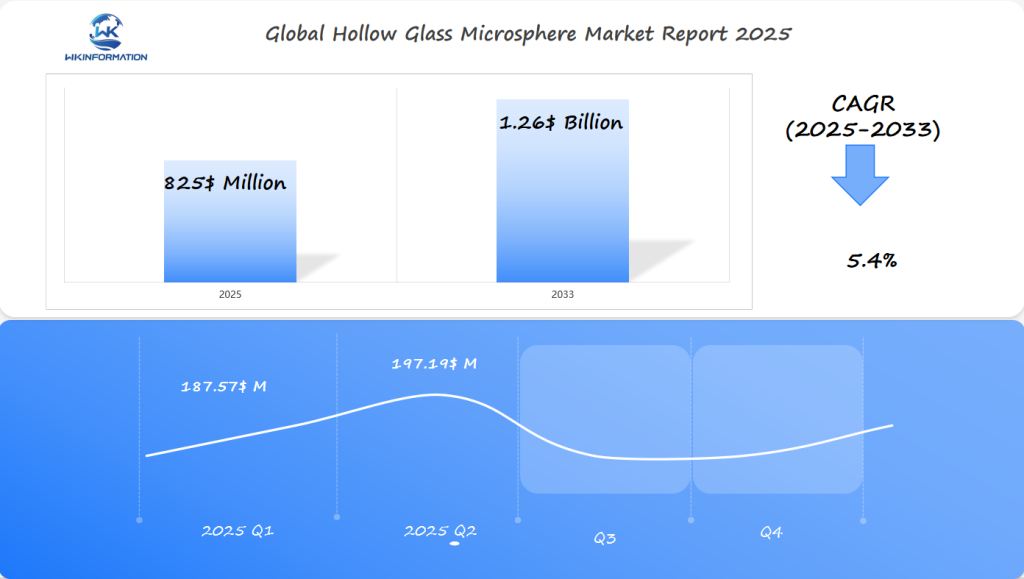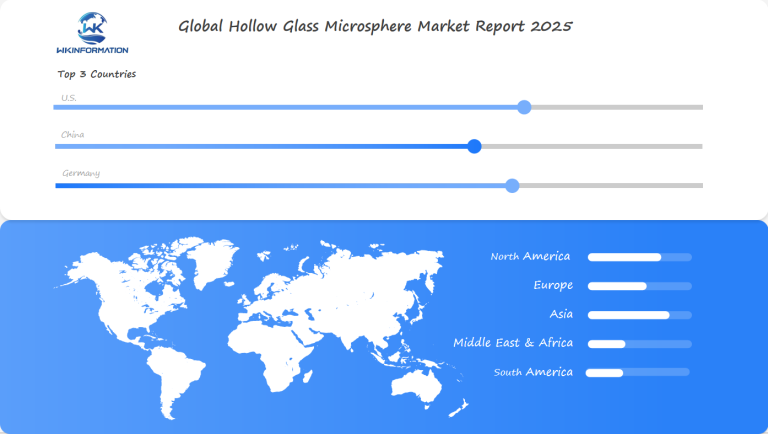$825 Million Hollow Glass Microsphere Market Set to Surge in the U.S., China, and Germany by 2025
The hollow glass microsphere market is projected to grow from approximately 825 Million USD in 2025 to 1.26 billion USD by 2033.
- Last Updated:
Projected Market Insights for Hollow Glass Microsphere in Q1 and Q2 of 2025
The Hollow Glass Microsphere market is projected to reach $825 million in 2025, with a CAGR of 5.4% from 2025 to 2033. In Q1, the market is expected to generate approximately $187.57 million, driven by the increasing use of microspheres in applications such as construction, automotive, and aerospace due to their lightweight properties. By Q2, the market is expected to rise to around $197.19 million, as demand for these microspheres grows for insulation, fireproofing, and other performance-enhancing purposes.
The U.S., China, and Germany are expected to lead the market. The U.S. benefits from strong demand in the aerospace and automotive sectors, while China’s rapid industrialization boosts demand for lightweight materials in construction and manufacturing. Germany’s robust automotive and manufacturing industries also drive significant demand for hollow glass microspheres. As industries continue to prioritize performance and weight reduction, the hollow glass microsphere market is set for steady growth.

Exploring the Upstream and Downstream Industry Chains for Hollow Glass Microspheres
Understanding the supply chain for hollow glass microspheres provides insights into both upstream production processes and downstream applications.
Upstream Production Processes:
- Raw Material Sourcing: The journey begins with acquiring raw materials, primarily recycled glass. This not only supports sustainability but also helps in conserving natural resources.
- Production Techniques: Transforming raw materials into hollow glass microspheres involves precise manufacturing techniques. High-temperature melting is used to form tiny spheres, followed by a controlled cooling process to achieve the desired hollow structure and consistency.
- Quality Control: Maintaining consistent quality is crucial, involving rigorous inspection at various stages of production to ensure each microsphere meets industry standards.
Downstream Applications:
Hollow glass microspheres find extensive use across various industries due to their unique properties:
- Aerospace: Valued for their lightweight nature, they are employed in composite materials to enhance fuel efficiency while maintaining structural integrity.
- Construction: Offering thermal insulation benefits, these microspheres contribute to energy-efficient building solutions. Their incorporation in construction materials helps reduce overall weight without compromising strength.
- Automotive: As the automotive industry seeks ways to improve fuel efficiency, hollow glass microspheres serve as fillers in plastics and composites, reducing vehicle weight and enhancing performance.
These diverse applications highlight how hollow glass microspheres fit seamlessly into modern industrial requirements, driven by the demand for energy efficiency and sustainability. The seamless integration of these spheres into existing production lines underscores their versatility and importance in contemporary manufacturing practices.
Key Trends Shaping the Hollow Glass Microsphere Industry
Market Trends and Energy Efficiency
The hollow glass microsphere industry is growing rapidly because more people want energy-efficient materials and lightweight solutions. As industries strive to use less energy, hollow glass microspheres are becoming increasingly popular for their ability to provide thermal insulation and reduce weight.
Applications in Various Industries
- Automotive Sector: In the automotive industry, these microspheres are used to enhance fuel efficiency by making vehicles lighter, which supports worldwide sustainability objectives.
- Construction Industry: In construction, hollow glass microspheres are incorporated into building materials to improve insulation properties while keeping structures lightweight.
- Aerospace Sector: The aerospace sector utilizes these microspheres in composite materials to achieve weight reduction without compromising strength, leading to more fuel-efficient aircraft.
The unique characteristics of hollow glass microspheres make them ideal for various applications across different industries, where energy efficiency and weight reduction are critical factors.
Regulatory Impact on Adoption
Energy efficiency regulations are playing a crucial role in shaping market trends. Industries such as construction and automotive are particularly affected by strict energy policies that require innovative material solutions. Hollow glass microspheres meet these regulatory requirements because they can enhance product performance while minimizing environmental impact. The focus on reducing carbon emissions further drives their adoption in various industries.
Manufacturing Advancements
Innovative manufacturing technologies have transformed the production of hollow glass microspheres, making it possible to create high-quality products with customized properties. Improvements in production methods allow manufacturers to adjust microsphere features like size, density, and strength to meet specific industry needs. This customization is essential for fulfilling different application requirements, such as buoyancy aids in marine equipment or fillers in composite materials for aerospace.
The combination of market trends, regulatory pressures, and technological advancements creates a dynamic environment for the hollow glass microsphere industry. These factors work together to promote innovation and adoption in multiple sectors, supporting the industry’s expected growth trajectory.
Challenges in Manufacturing and Scaling Hollow Glass Microspheres
Manufacturing hollow glass microspheres at scale presents several challenges that manufacturers must navigate to meet market demands.
Maintaining Consistent Quality
A primary concern lies in maintaining consistent quality during large-scale production. Variations in size, shape, and density can significantly impact the performance of these microspheres, making precise control over production parameters essential.
Controlling Costs
Another significant hurdle is controlling costs. The manufacturing process for hollow glass microspheres involves complex techniques that demand substantial energy and resources. As a result, producers face the dual challenge of optimizing production efficiency while keeping expenses in check to maintain competitiveness within the Hollow Glass Microsphere Market.
Implementing Quality Control Measures
Implementing robust quality control measures is crucial throughout the production process. By ensuring consistent quality, manufacturers can deliver products that meet the high-performance standards expected by various industries, such as aerospace and automotive. Quality control not only involves regular testing and inspection but also requires investment in advanced monitoring technologies to detect deviations early.
Scaling Production Capabilities
Moreover, as the demand for these materials grows, scaling production capabilities becomes imperative. Expansion often involves significant capital investment in new facilities or upgrading existing manufacturing infrastructure to accommodate increased output without compromising on product integrity.
Balancing Quality and Efficiency
The balance between maintaining high standards of quality and scaling efficiently is a delicate one. It necessitates ongoing research and development efforts aimed at refining production methodologies and adopting innovative solutions that streamline operations while preserving product excellence. As manufacturers strive to overcome these obstacles, they contribute to the dynamic growth trajectory of the hollow glass microsphere industry.

Geopolitical Factors Influencing the Hollow Glass Microsphere Market
Geopolitical influences are important in shaping the hollow glass microsphere market, affecting both production and distribution channels.
1. Trade Policies
Trade policies play a significant role in shaping economic influences, particularly in terms of pricing strategies and competition. When countries implement tariffs or trade barriers, manufacturers may experience higher costs, which can ultimately result in price changes for consumers. For example, conflicts between major manufacturing countries such as the U.S., China, and Germany can disrupt supply chains, causing variations in the availability and cost of raw materials. These disruptions are often a result of geopolitical risks, which further complicate the global economic landscape.
2. International Relations
International relations also play a significant role in shaping market dynamics. Positive diplomatic relationships often lead to smoother trade flows, while strained relations can result in sanctions or restrictions that hinder market growth. Countries with stable political environments tend to attract more investment in manufacturing facilities, further strengthening their position in the global market.
3. Regional Conflicts and Regulatory Changes
Beyond trade policies and international relations, geopolitical factors such as regional conflicts or shifts in regulatory frameworks can influence industry trends. For example, stricter environmental regulations in one region might prompt manufacturers to innovate more sustainable production methods, potentially setting new industry standards globally.
The interplay between these factors highlights the importance of adaptability for businesses operating within this space. Companies must stay informed about geopolitical developments to effectively navigate challenges such as fluctuating raw material costs or changes in import/export laws. By doing so, they can maintain competitive pricing strategies while ensuring a steady supply of high-quality hollow glass microspheres to meet growing demand across various industries.
Market Segmentation: Types and Applications of Hollow Glass Microspheres
Hollow glass microspheres come in various forms, primarily categorized by their shape and size.
1. Shape-Based Segmentation
- Spherical microspheres are the most common type, known for their uniformity and strength. These are often preferred in applications where structural integrity is crucial.
- Irregularly shaped microspheres offer unique benefits such as increased surface area, which can enhance bonding with other materials.
2. Size-Based Segmentation
Product segmentation based on size range is another critical factor. Microspheres typically vary from 1 micron to 500 microns.
- Smaller microspheres are advantageous for applications requiring smooth finishes or precise thermal insulation properties.
- Larger ones might be utilized in contexts where buoyancy or bulk filling is essential.
Hollow Glass Microspheres in Aerospace, Construction, and Automotive Sectors
Hollow glass microspheres have found applications in various industries due to their unique properties.
1. Automotive Industry
In the automotive industry, hollow glass microspheres are preferred because they can make vehicles lighter while still being strong. This weight reduction leads to better fuel efficiency, which is in line with worldwide energy efficiency regulations. Spherical microspheres are commonly used in this industry because they can support heavy loads and are easy to incorporate into composite materials.
2. Construction Industry
The construction industry also sees significant use of these materials, particularly for thermal insulation and lightweight concrete production. Irregular microspheres can provide enhanced bonding with construction chemicals, improving durability and lifespan of structures.
3. Aerospace Industry
Hollow glass microspheres are also used in industries such as aerospace, where there is a growing need for lightweight and strong materials. Their flexibility enables them to meet different industrial requirements, making them essential in multiple sectors.
Global Insights into the Hollow Glass Microsphere Market
The hollow glass microsphere market is experiencing significant growth, driven by increasing demand across industries such as aerospace, automotive, construction, and oil & gas. These lightweight, high-strength microspheres offer advantages like improved thermal insulation, reduced material weight, and enhanced durability.
Innovations in manufacturing processes and material compositions are further expanding their applications in high-performance coatings, composites, and advanced polymers. As industries prioritize energy efficiency and sustainability, the global market for hollow glass microspheres is expected to see continued expansion, with key players focusing on optimizing production costs and improving product performance.

U.S. Market Demand for Hollow Glass Microspheres in High-Tech Applications
In the United States, the demand for hollow glass microspheres is rising, particularly in high-tech applications such as aerospace, defense, and biomedical engineering. Their lightweight nature and superior mechanical properties make them essential for advanced composite materials used in aircraft, satellites, and medical devices.
Additionally, the growing interest in nanotechnology and 3D printing is driving further innovation in microsphere-based materials. With increased investments in research and development, U.S. companies are focusing on improving production efficiency and expanding their use in next-generation technologies.
China’s Growing Role in Hollow Glass Microsphere Production
China has become a major producer of hollow glass microspheres, taking advantage of its strong manufacturing infrastructure and cost-effective production capabilities. The country’s rapid industrial growth and expansion in industries like automotive, electronics, and construction have driven the demand for lightweight materials that perform well. Chinese manufacturers are investing in advanced production methods to improve product quality and serve both domestic and international markets.
With government initiatives supporting the development of high-tech materials, China is set to strengthen its position as a leading supplier in the global hollow glass microsphere industry.
Germany’s Expertise in Hollow Glass Microsphere Research and Development
Germany is known for its expertise in materials science and engineering, playing a key role in the research and development of hollow glass microspheres. German research institutions and industrial manufacturers are leading the way in creating high-performance microspheres with improved thermal, mechanical, and chemical properties.
The country’s strong emphasis on sustainability and energy efficiency is driving innovation in recyclable and eco-friendly microsphere formulations. Partnerships between universities, startups, and large corporations are also pushing the technology forward, ensuring Germany stays at the forefront of top-notch hollow glass microsphere solutions.
The Future Outlook for Hollow Glass Microspheres: Innovation and Sustainability Focused Initiatives
The Hollow Glass Microsphere Market is set to witness transformative developments as sustainability becomes a pivotal focus. Innovations in manufacturing processes are anticipated to significantly reduce the environmental impact. This involves utilizing recycled materials and implementing energy-efficient production techniques, which will contribute to lowering greenhouse gas emissions.
Sustainability-focused initiatives are expected to drive future growth, emphasizing the creation of microspheres with enhanced properties for eco-friendly applications. For instance, developments aimed at increasing the thermal insulation capacity of these microspheres can play a crucial role in reducing energy consumption in buildings and vehicles.
Advancements in technology may facilitate the production of hollow glass microspheres that are tailored specifically for renewable energy sectors, such as wind and solar power. Efforts to improve the biodegradability of these materials during end-use applications are also likely to gain traction, aligning with global sustainability goals and enhancing market appeal.
Competitive Landscape in the Hollow Glass Microsphere Industry
The Hollow Glass Microsphere Market has a competitive landscape with major players:
- Dennert Poraver —— Germany
- Sigmund Lindner —— Germany
- Cospheric —— USA
- TRELLEBORG —— Sweden
- AkzoNobel —— Netherlands
- Merit Medical Systems —— USA
- Polysciences —— USA
- Phosphorex Incorporated —— USA
- Sunjin Chemical —— South Korea
- 3M Company —— USA
Overall
| Report Metric | Details |
|---|---|
| Report Name | Global Hollow Glass Microsphere Market Report |
| Base Year | 2024 |
| Segment by Type |
|
| Segment by Application |
|
| Geographies Covered |
|
| Forecast units | USD million in value |
| Report coverage | Revenue and volume forecast, company share, competitive landscape, growth factors and trends |
The hollow glass microsphere market shows strong growth potential, with estimates predicting a value of USD 1.26 billion by 2033. Key industries like automotive, aerospace, construction, and healthcare continue to drive demand, while emerging markets in Asia-Pacific and Latin America offer significant opportunities. Technological advancements and the increasing need for lightweight, energy-efficient materials further support market growth.
Innovation and sustainability are crucial for future growth. Companies are prioritizing eco-friendly solutions to meet regulatory standards and consumer expectations. Efforts to reduce carbon emissions and improve recyclability align with global sustainability goals, ensuring the market’s relevance in a rapidly changing industrial landscape.
Stakeholders can take advantage of emerging opportunities by:
- Investing in research and development
- Exploring alternative raw materials
- Expanding applications across industries
The development of biodegradable microspheres and advancements in medical technology highlight the potential for innovation. By embracing these strategies, stakeholders can position themselves at the forefront of this dynamic market.
Global Hollow Glass Microsphere Market Report (Can Read by Free sample) – Table of Contents
Chapter 1: Hollow Glass Microsphere Market Analysis Overview
- Competitive Forces Analysis (Porter’s Five Forces)
- Strategic Growth Assessment (Ansoff Matrix)
- Industry Value Chain Insights
- Regional Trends and Key Market Drivers
- Hollow Glass Microsphere MarketSegmentation Overview
Chapter 2: Competitive Landscape
- Global Hollow Glass Microsphereplayers and Regional Insights
- Key Players and Market Share Analysis
- Sales Trends of Leading Companies
- Year-on-Year Performance Insights
- Competitive Strategies and Market Positioning
- Key Differentiators and Strategic Moves
Chapter 3: Hollow Glass Microsphere Market Segmentation Analysis
- Key Data and Visual Insights
- Trends, Growth Rates, and Drivers
- Segment Dynamics and Insights
- Detailed Market Analysis by Segment
Chapter 4: Regional Market Performance
- Consumer Trends by Region
- Historical Data and Growth Forecasts
- Regional Growth Factors
- Economic, Demographic, and Technological Impacts
- Challenges and Opportunities in Key Regions
- Regional Trends and Market Shifts
- Key Cities and High-Demand Areas
Chapter 5: Hollow Glass Microsphere Emerging and Untapped Markets
- Growth Potential in Secondary Regions
- Trends, Challenges, and Opportunities
Chapter 6: Product and Application Segmentation
- Product Types and Innovation Trends
- Application-Based Market Insights
Chapter 7: Hollow Glass Microsphere Consumer Insights
- Demographics and Buying Behaviors
- Target Audience Profiles
Chapter 8: Key Findings and Recommendations
- Summary ofHollow Glass Microsphere Market Insights
- Actionable Recommendations for Stakeholders

Access the study in MULTIPLEFORMATS
Didn’t find what you’re looking for?
TALK TO OUR ANALYST TEAM
Need something within your budget?
NO WORRIES! WE GOT YOU COVERED!
Call us on: +1-866-739-3133
Email: infor@wkinformation.com
What is the projected growth of the hollow glass microsphere market?
The hollow glass microsphere market is expected to reach a value of $825 million by 2025, with significant contributions from countries like the U.S., China, and Germany.
How do hollow glass microspheres contribute to lightweight materials in various industries?
Hollow glass microspheres are essential in creating lightweight materials that enhance energy efficiency across various industries such as aerospace, construction, and automotive.
What challenges do manufacturers face when producing hollow glass microspheres?
Manufacturers face challenges like:
- Ensuring consistent quality
- Managing production costs
- Effectively scaling their manufacturing capabilities
The Impact of Geopolitical Factors on the Hollow Glass Microsphere Market
Geopolitical factors, such as trade policies and international relations, have a significant impact on pricing strategies and the overall dynamics of the hollow glass microsphere market.
What are the main uses of hollow glass microspheres?
Hollow glass microspheres are mainly used in the automotive and construction industries. Different types of microspheres are chosen for their special qualities that enhance performance.
What future developments can we expect in the hollow glass microsphere industry?
Future developments in the hollow glass microsphere industry will focus on sustainability initiatives aimed at reducing environmental impacts during manufacturing processes and end-use applications.

